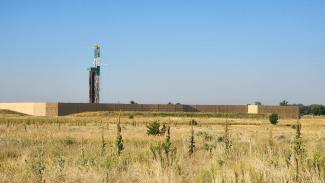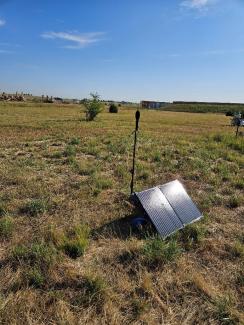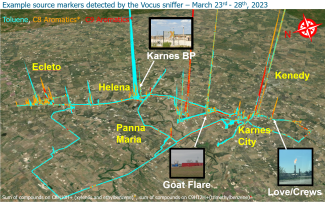Quarterly Update September 2023
HEI Energy's September 2023 Quarterly Research Updates are now available. You will find the latest progress from each of our 5 exposure studies in communities affected by oil and gas development.
Project Updates
Air Quality and Noise Research
Measuring and Modeling Air Pollution and Noise Exposure Near Unconventional Oil and Gas Development in Colorado
Read the full Research Report here
The goal of this study is to develop community exposure profiles in the Colorado North Front Range for chemicals in the air as well as noise over the UOGD lifecycle, from site preparation through production of multi-well pads. This study will assess potential exposure pathways connecting UOGD chemical emissions to nearby communities and use the results to better understand the public health implications. The investigators will apply the following methods to achieve these goals:
- Use a combination of existing air quality data, innovative air quality measurements, and source apportionment models to quantify potential exposures.
- Collect noise measurements from UOGD operations to quantify potential exposures.
- In collaboration with the Hildebrandt Ruiz team, develop the "TRAcking Community Exposures and Releases" (TRACER) model for use in the Denver-Julesburg region to predict chemical emissions from specific UOGD processes. The teams will combine the predicted emissions with an air quality model to estimate concentrations of chemicals in the air.
- Evaluate model performance by comparing air quality monitoring data collected by this and the Franklin team with model predictions in the Denver-Julesburg region.
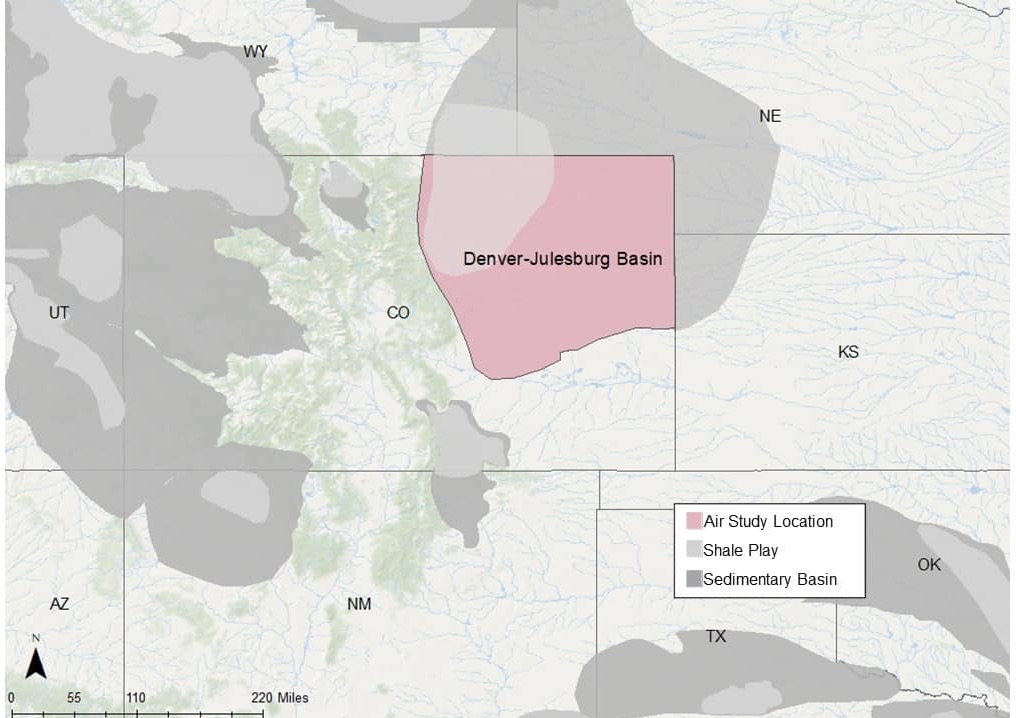
What's Happened
- Held a second Community Open House on August 23, 2023, at the Community Recreation Center in Brighton, Colorado. The open house was attended by state and local government officials, industry representatives, and community members. Posters were presented providing a study overview, in English and Spanish, an introduction to air monitoring activities, and an introduction to noise monitoring. The CSU mobile plume-tracker and stationery SPOD VOC sensors were on display.
- Completed monitoring of hydraulic fracturing operations at a study pad near Aurora, Colorado.
- Completed a third-party onsite audit of the project ensuring quality assurance of instruments, data collection, and data analysis.
- Toured and discussed drilling operations at a well pad near Brighton, Colorado.
What's New
- Monitoring air emissions from flowback at a well pad near Aurora, Colorado.
- Monitoring air emissions and noise from drilling at a well pad near Brighton, Colorado.
- Initiating a focused study on emissions from drilling mud at the well pad near Brighton. The team is collecting samples of drilling fluid, drilling mud (drilling fluid with added water and barite), and drill cuttings and sending them for laboratory analysis of VOCs. In addition, they are monitoring air quality on the well pad near various points in the drilling mud handling system to examine the chemical signature of emitted VOCs.
- Using detailed drilling records from the well pad near Aurora to construct a typical well pad activity timeline to help develop the TRACER emissions model.
- Gauging emission rates of VOCs during drilling operations in a separate study in Broomfield, Colorado, using hydrocarbon observations combined with dispersion modeling.
What's Next
- Continue monitoring noise and air emissions at the well pad near Brighton, Colorado into 2024.
- Wrap up air monitoring at the well pad near Aurora in the fall of 2023.
- Continue reviewing operational records with the well pad operator to facilitate interpretation of observations of emitted VOCs during hydraulic fracturing and initial production (also known as flowback operations).
- Conduct laboratory studies of VOC emissions from drilling fluid, drilling mud, and drill cutting samples collected from drilling operations on the well pad near Brighton.
- Continue discussions with operators to identify a third well pad to measure noise associated with new e-frac technologies, which are claimed to reduce noise during hydraulic fracturing operations.
Upcoming Events
- Dr. Jeff Collett to present on, “Using a spatial canister network to determine source contributions and local emission rates of methane and volatile organic compounds” at the Air & Waste Management Association Air Quality Measurements Conference, November 14-16, 2023, Durham, NC.
Assessing Source Contributions to Air Quality and Noise in Unconventional Oil Shale Plays
Read the full Research Report here
The goal of this study is to understand potential community exposure to UOGD-associated chemicals and radioactivity in air as well as noise. The investigators will apply the following methods to achieve their goals:
- Monitor air quality and noise in the Permian region of New Mexico and the Eagle Ford region of Texas to understand how potential exposures vary across the regions and over different time scales.
- Combine existing air monitoring data in the Denver-Julesburg region of Colorado and original data collected in the Permian and Eagle Ford regions with statistical models to distinguish UOGD from other sources of chemicals in the air and noise sources.
- Leverage satellite data to examine the association between natural gas flaring and air quality.
Collaborate with the Collett and Hildebrandt Ruiz teams to evaluate the "TRAcking Community Exposures and Releases" (TRACER) model performance in the Denver-Julesburg and Eagle Ford regions.
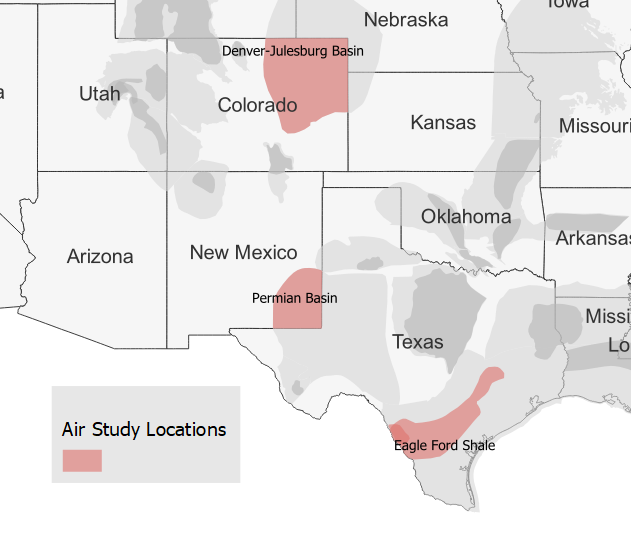
What's Happened
- Deployed a passive monitoring network around Carlsbad-Loving, NM, with the help of community volunteers. There are 6 monitors in the community and 1 monitor located with the stationary air quality and noise monitoring trailer in Loving, NM.
- Made monthly visits to the monitoring trailer in Loving, NM for routine maintenance, particle filter changes, and instrument checks.
- Completed a third-party audit of the project ensuring quality assurance of instruments, data collection, and data analysis.
- Created a web application that maps satellite-observed flaring across the Permian Basin and Eagle Ford Shale.
What's New
- Analyzing the air quality data and examining trends collected at the monitoring trailer.
- Setting up a weekly schedule with the community volunteers to collect the passive samplers and ship them to Dr. Gunnar Schade’s lab at Texas A&M University where he is analyzing them.
- Working with community volunteers to expand the passive sampling network (2 more planned for September 2023 deployment).
What's Next
- Create infographics to distribute to the community.
- Hold a community webinar in Carlsbad-Loving, NM in the fall of 2023 (Date and Time TBD).
- Begin recruitment of volunteers for passive sampler deployment in the Eagle Ford region.
Predictive, Source-oriented Modeling and Measurements to Evaluate Community Exposures to Air Pollutants and Noise from Unconventional Oil and Gas Development
The goal of this study is to develop a broadly applicable model, the "TRAcking Community Exposures and Releases" (TRACER) model. The model will assess potential community exposures to chemicals in the air from UOGD and inform future health studies. The model will then be used to predict the magnitude and frequency of emissions from individual UOGD sources, and when coupled with dispersion modeling, will generate concentrations of chemicals in the air. The investigators will apply the following methods to achieve their goals:
- Collect stationary and mobile air quality and noise measurements in the Eagle Ford, Texas region.
- In collaboration with the Collett team, develop the TRACER model in the Eagle Ford region to generate chemical emissions data from specific UOGD processes. The teams will combine the predicted emissions with air quality models to estimate local and regional concentrations of chemicals in the air.
- Expansion of the TRACER model to the Marcellus region, leveraging data from the separately funded Appalachian Methane Initiative.
- Evaluate model performance by comparing air quality monitoring data with model predictions in the Eagle Ford region.
- Use TRACER model results to assess spatial and temporal variability of potential community exposures to UOGD-associated chemicals and evaluate the effects of different UOGD sources on potential community exposures.
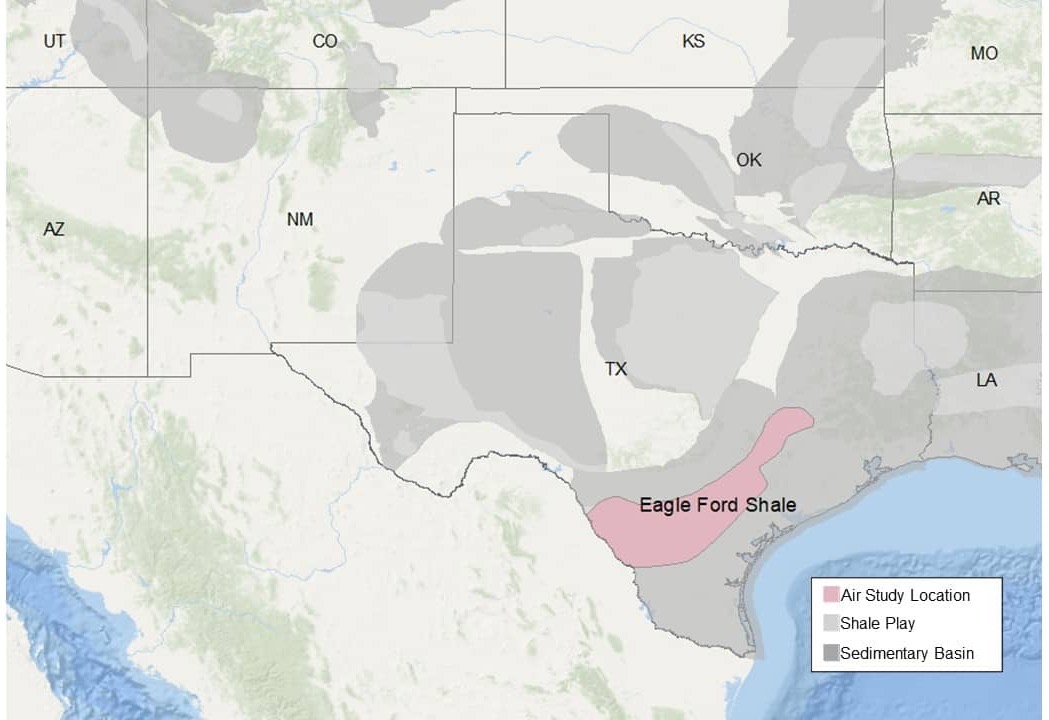
What's Happened
- Analyzed data collected during the first intensive measurement campaign in Spring 2023. Figure 1 shows several air emissions measured during two days of mobile sampling in the Karnes City region in Texas.
What's New
- Preparing for the next intensive measurement campaign in the Eagle Ford region.
- Setting up several different dispersion and exposure models.
- Continuing analysis of data collected from the first intensive measurement campaign in Spring 2023.
What's Next
- Take additional measurements in the Eagle Ford Shale in October and November 2023.
- Analyzing and completing quality assurance review of the data from both measurement campaigns, use the data to evaluate the performance of the TRACER model.
Upcoming Events
- The team will discuss their work during several presentations at the fall meeting of the American Geophysical Union, December 11-15 in San Francisco.
- Community Open House in Karnes City, TX on November 7, 2023 (Time TBD).
Figure 1: A map depicting several air emissions of organic compounds detected in the time period of March 23rd to the 28th, 2023 through mobile monitoring efforts in the Karnes City region in Texas.
Water Quality Research
Using Geoscientific Analysis and Community Engagement to Analyze Exposures to Potential Groundwater Contamination
Read the full Research Report here
The overall goal of this study is to evaluate potential linkages between unconventional oil and gas development (UOGD) and groundwater contamination in a tri-county region of Pennsylvania with many overlapping potential sources of contamination. The analysis will be informed by focus groups in the region to help identify areas of community concern. The team plans to produce a broadly applicable framework to study the relationship between specific UOGD processes and potential groundwater contamination. The investigators will apply the following methods to achieve their goals:
- Combine an existing data set of chemical measurements in groundwater with machine learning to isolate the influences of natural and anthropogenic processes on groundwater chemistry and to identify chemical signatures of UOGD.
- Evaluate linkages between UOGD and potential water contamination.
- Develop an approach to map locations of potential contamination from UOGD activities for application to future investigations of potential human exposures and health effects associated with UOGD.
- Collected and analyzed well water samples well water in “hot spots” identified through their analysis as likely locations of wastewater spills, in order to evaluate the team’s approach.
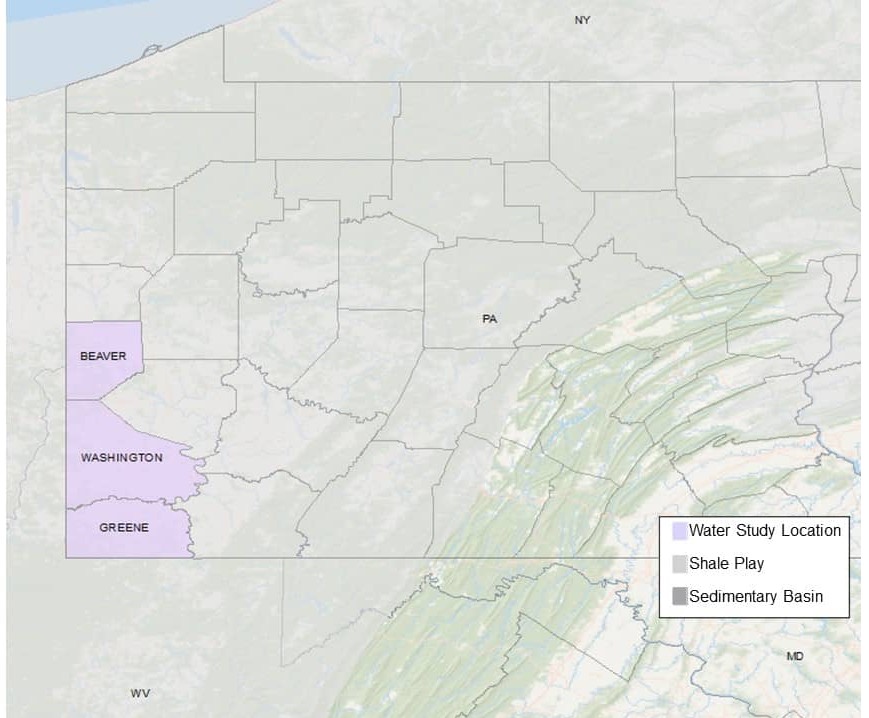
What's Happened
- The team held follow up focus groups in Beaver, Washington, and Greene Counties between July 31 and August 2 to discuss preliminary study results with community members. Attendees were very grateful and appreciative of the work.
- Sam Shaheen, Drs. Tao Wen, and Susan Brantley organized a session and associated fieldtrip for the 2023 Geological Society of America (GSA) conference, October 15-19, Pittsburgh, PA.
- Shaheen finalized a second geoscientific analysis paper for submission to the journal, Environmental Research Letters in September 2023.
What's New
- Analyzing the location of the hotspots identified in Shaheen et al. (2022) in terms of population, geology, industrial activities, and groundwater chemistry.
- Continuing exposure analysis.
What's Next
- Present findings to the HEI Research Committee, September 2023.
- Finalize project and submit final investigator report in the Fall of 2023.
- Submit focus group analysis paper for publication.
Upcoming Events
- Dr. Sue Brantley will give an invited Halbouty Lecture at the Geological Society of America Annual Meeting in Pittsburgh PA, Oct 17, 12:15-1:15p.m., entitled “How Fracking Affects our Water.”
- Sam Shaheen, Drs. Tao Wen, and Susan Brantley to host the following GSA sessions (Date and Time TBD)
- No Well Left Behind: Quantifying Impacts and Improving Management of Active, Abandoned, and Orphaned Oil and Gas Wells to Safeguard Air, Water, and Land Resources
- Fieldtrip: Fracking in the Oldest Commercial Oil Field: From Legacy Extraction to Environmental Impacts
Assessing the Effects of Unconventional Oil and Gas Development on Community Water Sources
The study is complete and now undergoing peer review and an independent quality assurance/quality control audit before HEI Energy releases the research report in the first part of 2026.
The goal of this study is to evaluate whether instances of community water supply contamination in Colorado and New Mexico might be the result of unconventional oil and gas development (UOGD). The study will be useful for understanding the UOGD operational conditions that might present a risk to community water supplies. The investigators will apply the following methods to achieve their goals:
- Analyze existing groundwater and surface water quality data for community water supplies near UOGD and examine correlations between water quality and oil and gas operational data.
- Examine temporal and spatial correlations between UOGD and community water supply contamination to identify possible exposure pathways.
- Model contaminant transport along possible exposure pathways to evaluate the feasibility of the pathways connecting community water supplies with UOGD.
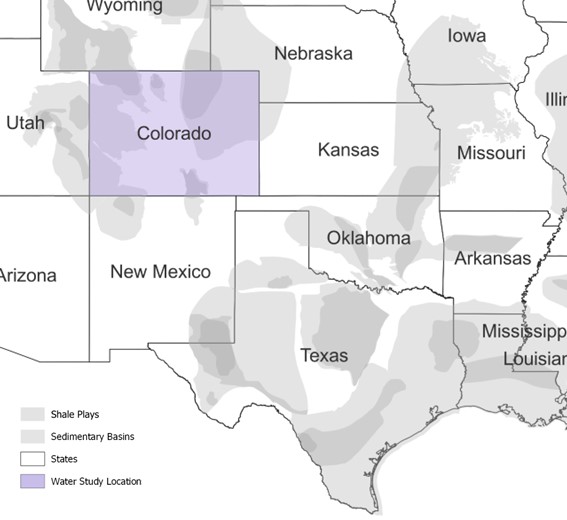
What's Happened
- Using groundwater flow and transport modeling, continued work assessing the feasibility of oil and gas development affecting community water supplies.
- Did not find sufficient water quality data for New Mexico community water supplies to conduct the same analyses conducted for Colorado community water supplies.
What's New
- Preparing four manuscripts for submission to peer-reviewed journals:
- Detailed examination of the co-occurrence of benzene, toluene, ethylbenzene, and xylenes with thermogenic methane and oil and gas well integrity in the Wattenberg Field of the Denver-Julesburg Basin in northeastern Colorado.
- Broad examination of the co-occurrence of benzene, toluene, ethylbenzene, and xylenes with thermogenic methane and oil and gas well integrity across Colorado, including oil and gas, dry gas, and coalbed methane basins.
- Assessment of the feasibility of contamination of water supplies by oil and gas development in Colorado using groundwater flow and transport modeling.
- Assessment of risks associated with contamination detected in water supplies near oil and gas development in Colorado, with recommendations for improving water supply protection.
What's Next
- Revising and submitting manuscripts as the study wraps up.
- Submitting final Investigator Report to HEI Energy for rigorous peer review.


